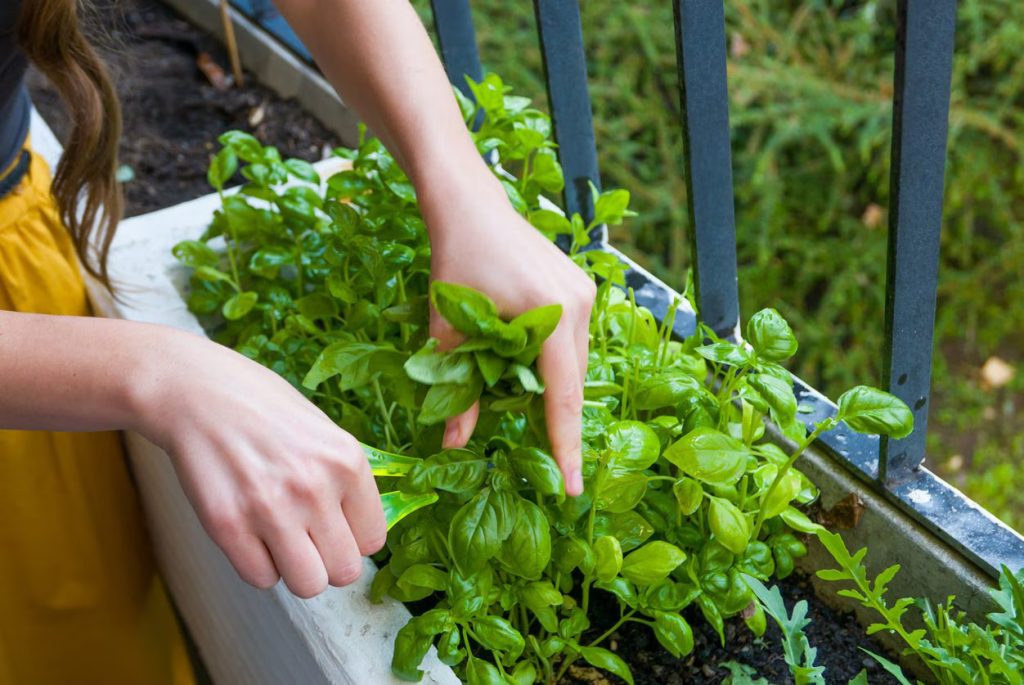Basil, the fragrant herb loved for its culinary versatility, thrives with regular harvesting. But the key to a continuous supply lies in knowing how to harvest without hindering the plant’s growth. Whether you’re a seasoned gardener or a beginner, these techniques will ensure your basil plant flourishes while you enjoy its flavorful leaves.
Understanding Basil Growth
Before we delve into harvesting methods, let’s understand how basil grows. This will help us determine the optimal time and approach for harvesting.
- Growth pattern: Basil grows in pairs of leaves along a central stem. New growth emerges from the top, while the lower leaves mature.
- Flowering: Basil plants eventually produce flowers, which signal the end of their vegetative growth phase. Harvesting before flowering encourages the plant to produce more leaves.
Related: How to Grow Kiwi Plant in Your Garden and Take Proper Care
Harvesting Techniques
There are three main techniques for harvesting basil, each with its own benefits:
- Pinching individual leaves: This is ideal for small, frequent harvests.
- Method: Simply pinch off individual leaves at their base, where they meet the stem. Start from the top and work your way down.
- Benefits: Encourages bushier growth and allows you to selectively harvest leaves at their peak flavor.
- Cutting stems: Perfect for larger harvests or when you need longer stems for culinary use.
- Method: Use clean, sharp scissors or pruners to cut stems just above a pair of leaves. Aim for about ¼ inch above the leaf node.
- Benefits: Promotes new growth from the cut point and results in a more substantial harvest.
- Pruning the plant: This is a more comprehensive approach for controlling growth and encouraging bushier development.
- Method: Identify the main stem and cut it back by about a third, just above a pair of leaves. This will encourage side shoots to grow, resulting in a fuller plant.
- Benefits: Maximizes leaf production and prevents the plant from becoming leggy.
When to Harvest Basil
The best time to harvest basil is when the plant is at least 6-8 inches tall and has several sets of leaves. However, you can start pinching off individual leaves earlier to encourage growth. The most flavorful leaves are typically found before the plant flowers. If you’re interested in other gardening techniques, you might want to learn how to harvest willow cuttings. For detailed instructions, visit https://hatchettgardendesign.com/plants/how-to-plant-willow-cuttings/.
Harvesting Tips for Optimal Growth
To ensure your basil plant thrives after each harvest, follow these tips:
- Water regularly: Basil prefers consistently moist soil, especially during hot weather.
- Fertilize occasionally: Use a balanced fertilizer every few weeks to replenish nutrients.
- Harvest regularly: Don’t be afraid to harvest often. The more you pick, the more the plant will grow!
- Prevent flowering: If you see flower buds forming, pinch them off to encourage leaf production.
- Protect from pests: Basil can be susceptible to pests like aphids and spider mites. Monitor regularly and take appropriate action if needed.
Beyond the Harvest
Once you’ve harvested your basil, there are numerous ways to enjoy its fresh flavor. Use it in salads, pesto, sauces, or simply add it to your favorite dishes for an aromatic boost. If you have a surplus, consider drying or freezing it to preserve its flavor for later use.
Conclusion
Harvesting basil is a rewarding process that allows you to savor the fruits of your labor. By understanding the plant’s growth pattern and employing the right techniques, you can ensure a continuous supply of this flavorful herb while maintaining a healthy, productive plant. Remember, regular harvesting is key to maximizing your basil bounty, so don’t hesitate to pick those leaves and enjoy the fresh, aromatic flavors they bring to your culinary creations.
Additional Resources:
- For more specific information on basil varieties and their unique characteristics, consult a reliable gardening guide or online resource.
- If you encounter any problems with your basil plant, don’t hesitate to seek advice from a local gardening expert or nursery.





Average Rating